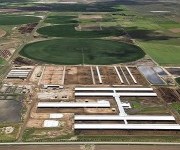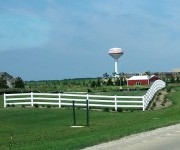Yorkville: a quiet rural community until the McMansions sprouted.Photo: Liza PThere’s nothing more depressing than having to stay in a hotel surrounded by acres of parking lots, arterial roads, and freeways — unless you’re caught in the permanent-housing equivalent of an airport hotel: the exurb. Sprung from its predecessor the suburb, these even farther-off ‘burbs lie scores of miles away from big cities and are often filled with houses and little else. They boomed during the housing bubble, but took a terrific tumble in the crash. They were based on three simple but ultimately flawed premises: housing prices will continue to rise, metro areas will continue to expand, and gas prices will continue to stay low. Oops.
Perhaps nowhere is this blight more evident than in the seat of Illinois’ Kendall County: Yorkville, situated 50 miles from Chicago’s Loop. Kendall County led the pack when it came to exurban growth in the 2000s. It was the fastest growing county in the country — its 110 percent growth rate outpaced even the surging southern sprawlburbias. Dirk Johnson at the Chicago News Cooperative details Kendall County’s remarkable fall:
In 2009 and 2010, the top foreclosure rates in Illinois were in Kendall, Kane, and Will Counties. On the new suburban frontier along the farthest fringes of the Chicago region, where cheap land and rising prices once triggered a rush of buyers, some newer developments have become ghost towns in places like Yorkville, Frankfort, Sugar Grove, and Hampshire.
Instead of corn, farm fields sprouted McMansions. They emerged wherever speculation was highest, like small shoots in anticipation of rain. But in some places, the rain never came.
Fuel prices soared, housing demand tanked, and Kendall County’s growth stalled. It sounds like a tale of deserved comeuppance for hubris, but the community simply responded to the signals the market gave them. The tone of the story takes a turn when you realize the people who live here — who always lived here — are the ones that will suffer the most. Workaday folks who bought at the wrong time are now trapped in their homes. Kids who once had time for extracurriculars now have to work a job to help the family. The school district built a gleaming $183-million high school to accommodate the crush of students that never came. As a result, the district has had to cut expenses even more than most.
It’s easy, in hindsight, to harshly judge exurbs like Kendall County, but the reality is, they didn’t have time to prepare. The housing boom hit them like a gold rush, and their governments and people were ill-prepared. Towns like Yorkville, which started the decade with just over 6,000 people, do not have the planning mechanisms in place to properly deal with the nearly 18,000 people it has now.
Such growth is usually dependent on an outside factor: the city. There simply aren’t enough jobs in those towns to make mixed-use development happen. The story of Yorkville is a cautionary tale for small towns on the fringe of metropolitan areas: Have a plan in place. No one wants to become an unsustainable exurb, but few prepare for the possibility. Explosive growth isn’t always a panacea. Allow too much and it’ll not only ruin a small town’s charming character — it could kill its future.



